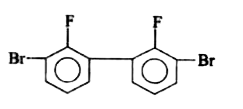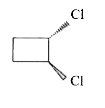Which of the following species will be optically active ?




The correct Answer is:C
To determine which of the given species are optically active, we need to understand the concept of optical activity. A compound is optically active if it can rotate the plane of polarized light, which typically occurs when the compound is chiral. Chirality means that the molecule has a non-superimposable mirror image, often due to the presence of a chiral center (usually a carbon atom bonded to four different substituents).
Let's analyze the options step by step:
Step 1: Identify the nature of each option
1. Geometrical Isomers (Cis and Trans):
- Geometrical isomers can be cis or trans forms. These isomers often have a plane of symmetry, which means they are superimposable on their mirror images. Therefore, they are not chiral and are optically inactive.
2. Nitrogen with Four Different Substituents:
- If a nitrogen atom is bonded to four different groups, it creates a chiral center. Chiral nitrogen can lead to optical activity, as it does not have a plane of symmetry. Thus, this species is optically active.
3. Two Rings with Different Planes:
- If the two rings are oriented in such a way that they are not superimposable on their mirror images (for example, due to a 90-degree twist), this can create chirality. Therefore, this compound is also optically active.
4. Triple Bond with Geometrical Isomers:
- Similar to the first option, if the compound exhibits geometrical isomerism (cis and trans) due to a triple bond, it likely has a plane of symmetry and is superimposable on its mirror image. Hence, it is optically inactive.
Conclusion:
Based on the analysis:
- Option 1: Optically inactive (wrong option).
- Option 2: Optically active (correct option).
- Option 3: Optically active (correct option).
- Option 4: Optically inactive (wrong option).
Thus, the correct options that are optically active are B and C.
---
1. Geometrical Isomers (Cis and Trans):
- Geometrical isomers can be cis or trans forms. These isomers often have a plane of symmetry, which means they are superimposable on their mirror images. Therefore, they are not chiral and are optically inactive.
- If a nitrogen atom is bonded to four different groups, it creates a chiral center. Chiral nitrogen can lead to optical activity, as it does not have a plane of symmetry. Thus, this species is optically active.
- If the two rings are oriented in such a way that they are not superimposable on their mirror images (for example, due to a 90-degree twist), this can create chirality. Therefore, this compound is also optically active.
- Similar to the first option, if the compound exhibits geometrical isomerism (cis and trans) due to a triple bond, it likely has a plane of symmetry and is superimposable on its mirror image. Hence, it is optically inactive.
Based on the analysis:
- Option 1: Optically inactive (wrong option).
- Option 2: Optically active (correct option).
- Option 3: Optically active (correct option).
- Option 4: Optically inactive (wrong option).
Topper's Solved these Questions
- STEREOISOMERISMBook:RESONANCE ENGLISHChapter:STEREOISOMERISMExercise:EXERCISE (PART II : NATIONAL STANDARD EXAMINATION IN CHEMISTRY (NSEC) STAGE-1)
Explore 55 Videos
- STEREOISOMERISMBook:RESONANCE ENGLISHChapter:STEREOISOMERISMExercise:EXERCISE (PART III : PRACTICE TEST-2 (IIT-JEE (ADVANCED PATTERN))
Explore 23 Videos
- STEREOISOMERISMBook:RESONANCE ENGLISHChapter:STEREOISOMERISMExercise:EXERCISE (PART -II ONLINE JEE MAIN)
Explore 3 Videos
- SOLUTIONSBook:RESONANCE ENGLISHChapter:SOLUTIONSExercise:Advabced Level Problems (PART-2)
Explore 35 Videos
- STRUCTURAL IDENTIFICATIONBook:RESONANCE ENGLISHChapter:STRUCTURAL IDENTIFICATIONExercise:Advanced level Problems (Part-III)
Explore 12 Videos
Similar Questions
Knowledge Check
Which of the following compounds will be optically active?
A B
B C
C D
D
Which of the following compounds is optically active ?
A1-BromobutaneB2-BromobutaneC1-Bromo-2-methylpropaneD2-Bromo-2-methylpropaneWhich of the following compounds is optically active?
A B
B C
C D
D
Which of the following biphenyls is optically active?
View SolutionWhich of the following compounds are optically active ?

View SolutionWhich of the following alkanes is optically active ?
View SolutionWhich of the following complex is optically inactive
View SolutionWhich of the following compounds is optically active?
View Solution
